Table of Contents
Introduction
When it comes to Manuka honey, you may have come across different grades, such as MGO 50+ or MGO 1000+. But what exactly do these grades mean? In this article, we will explore the significance of MGO grades and how they determine the potency of Manuka honey.
How is Manuka Honey Graded?
Manukora Manuka honey undergoes extensive testing at third-party laboratories to ensure authenticity, potency, and safety. One of the crucial tests conducted is the Methylglyoxal (MGO) test. This test measures the concentration of MGO in the honey, which determines its strength or potency.
Once the MGO testing is completed and the honey meets all other requirements, it is packaged and labeled with the closest MGO grade. Manukora offers MGO grades ranging from MGO 50+ to MGO 1000+ and above for special harvests. The labels clearly state the minimum level of MGO present in the honey, although it often exceeds this amount.
What is So Special About MGO?
MGO is a naturally occurring antibacterial compound found in the nectar of the Manuka tea tree flower. This nectar contains a unique natural sugar called DHA (dihydroxyacetone). Bees convert some of the DHA into MGO, while the remaining DHA slowly releases more of this powerful constituent in the honey.
Extensive studies have demonstrated the antibacterial properties of MGO, including its ability to inhibit harmful bacteria like E Coli and MRSA. Moreover, MGO serves as a marker for potency, as higher MGO levels indicate a higher concentration of other key bioactive compounds, such as Leptosperin, an antioxidant found only in Manuka honey.
Why Do MGO Levels Differ?
Several factors contribute to the variation in MGO levels in Manuka honey:
-
Geographical Location: New Zealand’s diverse geography, ranging from subtropical rainforests to snow-capped mountains, results in different strains of Manuka tea trees and variations in soil composition. These factors impact the MGO levels in the honey.
-
Weather: Weather conditions play a crucial role in the concentration of MGO. The Manuka tea tree flowers for a limited period, typically two to six weeks during the summer, and requires hot and sunny weather for optimal nectar flow. New Zealand’s variable weather leads to different results each year, even from the same locations.
-
Beekeeping: Manukora’s master beekeepers have access to remote Manuka forests and prioritize high-quality beekeeping practices to ensure the bees remain healthy year-round. Healthy bees are essential for producing highly active Manuka honey during the short nectar flow season.
The UMF Rating System
The Unique Manuka Factor (UMF) grading system, developed by the UMF Association, helps identify genuine Manuka honey. Manukora is a member of this association. The UMF grading system tests for MGO, DHA, HMF, and Leptosperin. The UMF grade is directly linked to MGO, with higher MGO levels corresponding to higher UMF grades.
For example:
- UMF 5+ corresponds to MGO 83+
- UMF 10+ corresponds to MGO 263+
- UMF 15+ corresponds to MGO 514+
- UMF 20+ corresponds to MGO 829+
Manukora conducts extensive testing, covering all UMF tests, and additional safety tests not covered by UMF, such as glyphosate residue. Customers can access these test results through the QR trace system provided.
To ensure clarity and simplicity, Manukora uses only the MGO system for grading on their labels.
Conclusion
The concentration of key bioactive compounds in Manuka honey is crucial for its potency and effectiveness. However, these concentrations can vary due to natural and environmental factors. Understanding the grading system can be confusing, but it is essential for making informed choices when purchasing Manuka honey.
Manukora’s MGO grading system ensures high levels of all key bioactive compounds in their honey. The higher the MGO number, the higher the concentration of the unique antibacterial compound MGO, as well as other bioactives like Leptosperin. When buying Manukora Manuka honey, you can be confident in its rich, smooth, and creamy caramel flavor, sourced from the rare and beautiful Manuka tea tree in the wild forests of New Zealand.
For further information on understanding the significance of different honey gradings and the colors associated with various honey types, you can refer to the Honey Gluten-Free Guide and Manuka Honey Color Guide. If you are interested in the digestive health benefits of Manuka honey, our guide on Manuka Honey for Digestive Health offers valuable insights.
When it comes to high UMF Manuka honey, Manukora stands as a reliable source for premium quality honey that meets the highest standards. So, if you’re in search of manuka honey high UMF, look no further than Manukora for a truly exceptional product.



